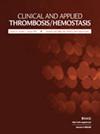International Normalized Ratio Predicts Recurrence and Bleeding in Patients With Acute Venous Thromboembolism Who Undergo Direct Oral Anticoagulants
IF 2
4区 医学
Q2 HEMATOLOGY
引用次数: 0
Abstract
Prothrombin time/international normalized ratio (PT/INR) is related to both antithrombotic effect and risk of bleeding. Its role in the prediction of venous thromboembolism (VTE) recurrence and bleeding for patients with acute VTE who undergo direct oral anticoagulants (DOACs) treatment is unclear, despite previous studies revealed some association between them. The predictive efficiency of INR for VTE recurrence and bleeding were analyzed in a retrospective cohort with VTE patients who underwent DOACs treatment. Then its predictive efficiency for VTE recurrence and bleeding were validated in a prospective cohort with the acquired cutoffs range, and compared with anti-Xa level, DASH and VTE-BLEED scores. In the retrospective cohort ( n = 1083), the sensitivity and specificity of INR for the prediction of VTE recurrence were 79.4% and 92.8%, respectively. The area under the curve (AUC) was 0.881 (0.803-0.960)( P = .025). The cutoff value of INR was 0.9. The sensitivity and specificity of INR for the prediction of bleeding were 85.7% and 77.9%, respectively. The AUC was 0.876 (0.786-0.967)( P < .001). The cutoff value of INR was 2.1. In the prospective cohort ( n = 202), the calibration showed that there were 4 (50%) patients with VTE recurrence, 156 (97.5%) patients with non-recurrence and bleeding (non-R&B), and 20 (58.8%) patients with bleeding in the low (INR < 0.9)( n = 8), intermediate (0.9 ≤ INR ≤ 2.1)( n = 160), and high (INR > 2.1)( n = 34) groups, respectively. The baseline PT/INR value at the initiation of DOACs treatment is an independent predictor for VTE recurrence and bleeding in patients with acute VTE who undergo DOACs treatment.国际标准化比率可预测接受直接口服抗凝药物治疗的急性静脉血栓栓塞症患者的复发和出血情况
凝血酶原时间/国际标准化比值(PT/INR)与抗血栓效果和出血风险有关。尽管之前的研究显示两者之间存在一定的联系,但其在预测接受直接口服抗凝药(DOACs)治疗的急性 VTE 患者的静脉血栓栓塞(VTE)复发和出血方面的作用尚不明确。一项回顾性队列研究分析了 INR 对接受 DOACs 治疗的 VTE 患者 VTE 复发和出血的预测效率。然后在前瞻性队列中验证了 INR 对 VTE 复发和出血的预测效率,并将其与抗 Xa 水平、DASH 和 VTE-BLEED 评分进行了比较。在回顾性队列(n = 1083)中,INR 预测 VTE 复发的敏感性和特异性分别为 79.4% 和 92.8%。曲线下面积(AUC)为 0.881 (0.803-0.960)( P = .025)。INR 的临界值为 0.9。INR 预测出血的敏感性和特异性分别为 85.7% 和 77.9%。AUC为0.876 (0.786-0.967)( P < .001)。INR 的临界值为 2.1。在前瞻性队列(n = 202)中,校准结果显示,低(INR <0.9)组(n = 8)、中(0.9 ≤ INR ≤ 2.1)组(n = 160)和高(INR >2.1)组(n = 34)分别有 4 例(50%)VTE 复发患者、156 例(97.5%)未复发和出血(非 R&B)患者和 20 例(58.8%)出血患者。在接受 DOACs 治疗的急性 VTE 患者中,开始 DOACs 治疗时的基线 PT/INR 值是 VTE 复发和出血的独立预测因子。
本文章由计算机程序翻译,如有差异,请以英文原文为准。
求助全文
约1分钟内获得全文
求助全文
来源期刊
CiteScore
4.40
自引率
3.40%
发文量
150
审稿时长
2 months
期刊介绍:
CATH is a peer-reviewed bi-monthly journal that addresses the practical clinical and laboratory issues involved in managing bleeding and clotting disorders, especially those related to thrombosis, hemostasis, and vascular disorders. CATH covers clinical trials, studies on etiology, pathophysiology, diagnosis and treatment of thrombohemorrhagic disorders.

 求助内容:
求助内容: 应助结果提醒方式:
应助结果提醒方式:


